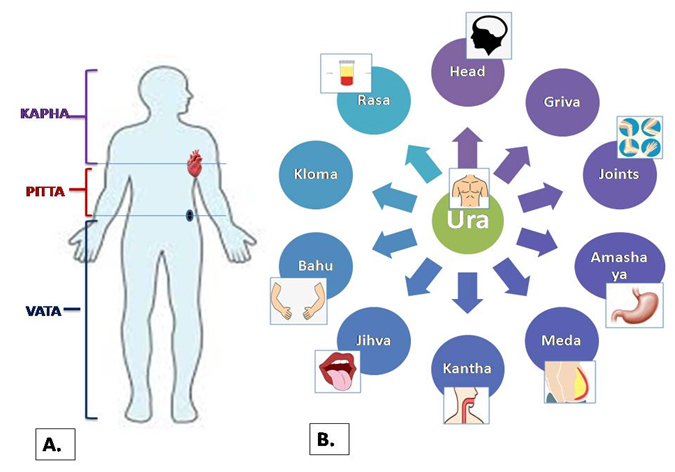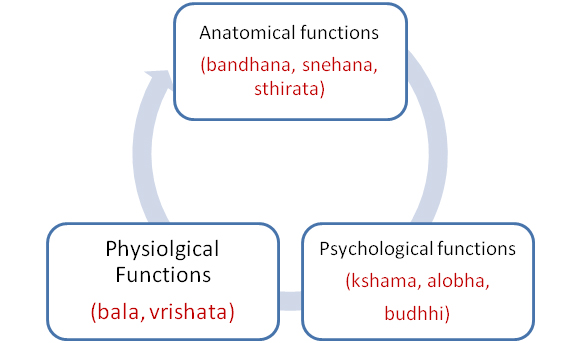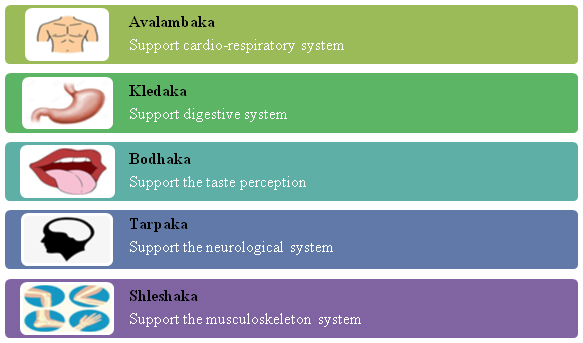Difference between revisions of "Kapha dosha"
Jump to navigation
Jump to search
Figure 04: Location and Physiological aspect of different types of kapha.
| Line 120: | Line 120: | ||
| Avalambaka [Code:SAT-B.415]<ref name="ref1"/> | | Avalambaka [Code:SAT-B.415]<ref name="ref1"/> | ||
| Chest(ura) | | Chest(ura) | ||
| − | | * Supports trika(area of conjugation of head with two arms) [Dalhana on Su.Sa. Sutra Sthana 21/12-14]<ref name="ref3"/> by its inherent power(trikasandharana) | + | | |
| + | * Supports trika(area of conjugation of head with two arms) [Dalhana on Su.Sa. Sutra Sthana 21/12-14]<ref name="ref3"/> by its inherent power(trikasandharana) | ||
* Support and maintain the structural and functional integrity of heart by power of nutrients present in food(annarasa).(annarasasahitenhridyaavalambana) | * Support and maintain the structural and functional integrity of heart by power of nutrients present in food(annarasa).(annarasasahitenhridyaavalambana) | ||
* Supports other kapha sites(sheshanam cha shleshmasthananamavalambanat) | * Supports other kapha sites(sheshanam cha shleshmasthananamavalambanat) | ||
| Line 127: | Line 128: | ||
| Kledaka [Code:SAT-B.416]<ref name="ref1"/> | | Kledaka [Code:SAT-B.416]<ref name="ref1"/> | ||
| Stomach(amashaya) | | Stomach(amashaya) | ||
| − | | * Liquefication and disintegration of food articles to facilitates easy digestion.(praklinnambhinnasanghata or annasanghatakledanat) | + | | |
| + | * Liquefication and disintegration of food articles to facilitates easy digestion.(praklinnambhinnasanghata or annasanghatakledanat) | ||
* Supports the other kapha sites through its inherent qualities. | * Supports the other kapha sites through its inherent qualities. | ||
|- | |- | ||
| Line 133: | Line 135: | ||
| Bodhaka [Code:SAT-B.417]<ref name="ref1"/> | | Bodhaka [Code:SAT-B.417]<ref name="ref1"/> | ||
| Root of tongue(jihvamula) <br/>Throat(kantha) | | Root of tongue(jihvamula) <br/>Throat(kantha) | ||
| − | | * Facilitates the perception of taste(rasajyane) | + | | |
| + | * Facilitates the perception of taste(rasajyane) | ||
|- | |- | ||
| 04. | | 04. | ||
| Tarpaka [Code:SAT-B.418]<ref name="ref1"/> | | Tarpaka [Code:SAT-B.418]<ref name="ref1"/> | ||
| Head (shira) | | Head (shira) | ||
| − | | * Due to presence of natural qualities, it nourishes the sense organs.(tarpanata) | + | | |
| + | * Due to presence of natural qualities, it nourishes the sense organs.(tarpanata) | ||
|- | |- | ||
| 05. | | 05. | ||
| Shleshaka [Code:SAT-B.419]<ref name="ref1"/> | | Shleshaka [Code:SAT-B.419]<ref name="ref1"/> | ||
| Joints (sandhi) | | Joints (sandhi) | ||
| − | | * Maintains the structural and functional integrity of all joints.(sarvasandhisanshleshat, sarva sandhi anugraha) | + | | |
| + | * Maintains the structural and functional integrity of all joints.(sarvasandhisanshleshat, sarva sandhi anugraha) | ||
|- | |- | ||
|} | |} | ||
Revision as of 13:56, 27 December 2022
Kapha dosha controls body fluids and maintains the structural cohesion of the organism. It is one of the three dosha. It is responsible for cohesiveness, unctuousness, lubricity, stability, and immunity. Kapha dosha has dominance of prithvi and jala mahabhuta.[Code:SAT-B.414][1] The concept of kapha is the foundation for growth, preservation, and anabolism theories.
| Section/Chapter/topic | Concepts/Dosha/Kapha Dosha |
|---|---|
| Authors |
Bhojani M. K. 1, Tanwar Ankur Kumar 1 |
| Reviewer | Basisht G.2, |
| Editor | Deole Y.S.3 |
| Affiliations |
1 Department of Sharir Kriya, All India Institute of Ayurveda, New Delhi, India 2 Rheumatologist, Orlando, Florida, U.S.A. 3Department of Kayachikitsa, G.J.Patel Institute of Ayurvedic Studies and Research, New Vallabh Vidyanagar, Gujarat, India |
| Correspondence emails |
meera.samhita@aiia.gov.in, carakasamhita@gmail.com |
| Publisher | Charak Samhita Research, Training and Development Centre, I.T.R.A., Jamnagar, India |
| Date of publication: | December 16, 2022 |
| DOI | 10.47468/CSNE.2022.e01.s09.123 |
Etymology and derivation
The word kapha is derived from root “kena jalena phalati iti kapha”.[2] It implies that water is the foundation of the kapha. The term ‘Shleshma’ used for kapha is derived from the root “ shlish alingane”.[3][Su. Sa.Sutra Sthana 21/5] The meaning is to cohere, to keep together, or to adhere.
Synonyms:[3][4]
In normal states-Shleshma [Cha. Sa. Sutra Sthana 12/12], bala[Cha. Sa. Sutra Sthana 17/117], oja[Cha. Sa. Sutra Sthana 17/117], balasa[Su. Sa. Sharira Sthana 4/74][3] [Vachaspati on M.N. 2/40][4] balasaka[Vijayarakshita on M.N. 2/40][4], Soma[Cha. Sa. Sutra Sthana 12/12]
In abnormal states- Papma, mala[Cha. Sa. Sutra Sthana 17/117]
In abnormal states- Papma, mala[Cha. Sa. Sutra Sthana 17/117]
Various aspects:
Kapha is related to bala(strength) to perform work. It is a potential source of resistance to disease and aging. It is responsible for union and integration. Soma or water in the body, is implicit in the kapha. [Cha. Sa. Sutra Sthana 12/12] The body weight and growth are both regulated by kapha. It bestows stability and toughness. It is a crucial element in the healing process and is regarded as virility, robust sexual health, and reproductive ability. All biological fluids, whether internal or extracellular, are composed of kapha and serve essential purpose of body. It oversees many types of cohesiveness between cells, tissue, and organs.
Bhautika composition
Kapha dosha has dominance of Jala and Prithvi mahabhuta.[5][A.S. Sutra Sthana 20/2] Although all the mahabhuta participate in the composition, jala mahabhuta expresses dominant role and Prithvi mahabhuta as secondary. Acharya sushruta opines that kapha dosha originatesfrom saumya or jalamahabhuta.[3][Su.Sa. Sutra Sthana42/5] [DalhanaSu.Sa. Sutra Sthana 15/8](Figure 01)
Kapha dosha and triguna
All the living & nonliving thingsoriginate from panchamahabhuta. These panchamahabhutaoriginate from trigunatmaka prakriti as described in evolution process (utpatti karma). Dosha evolve from panchamahbhuta, so these dosha bear triguna property. Sushruta stated that kaphaevolved from jala and prithvi. Jala has sattva and tama predominance. Prithvihas tama predominance [3] [Su. Sa.ShariraSthana 1/20] Shharangdhara and Bhavaprakashopine that kaphahas tama predominance. [Sha.Sa.Pratham Khand 5][6] [Bha. Pra. Purva Khand 3/103][7] (Figure 01)
Figure 01: Relation between Triguna, Mahabhuta and Kapha Dosha.
Sites of kapha
Dosha are present all over the body. [Cha.Sa. Sutra Sthana 20/9] They have specific sites in normal physiological conditions. The general location of kapha is the upper parts of the body. It is marked as above the heart(hridaya).[A.S. Sutra Sthana 1/4][5] Thes pecific seats of kapha areas below: [Code:SAT-B.238][1] [Code:SAT-B.420][1](Figure 02)
Figure 02. General(A) and specific sites(B) of kapha dosha.
- Chest(Ura)[Cha.Sa. Sutra Sthana 20/9] [Su. Sa.SutraSthana 21/7][3][A.S. Sutra Sthana 20/3][5][A.Hr. Sutra Sthana 12/3][8] [K.S. Sutra Sthana 27/11][9]
- Head (shira)[Cha.Sa. Sutra Sthana 20/9] [Su. Sa.SutraSthana 21/7][3][A.S. Sutra Sthana 20/3][5][A.Hr. Sutra Sthana 12/3][8]
- Neck region(griva)[Cha.Sa. Sutra Sthana 20/9][K.S. Sutra Sthana 27/11][9]
- Joints (parva or sandhi)[Cha.Sa. Sutra Sthana 20/9] [Su. Sa.SutraSthana 21/7][3] [A.S. Sutra Sthana 20/3][5][A.Hr. Sutra Sthana 12/3][8][K.S. Sutra Sthana 27/11][9]
- Stomach(amashaya)[Cha.Sa. Sutra Sthana 20/9] [A.S. Sutra Sthana 20/3][5] [A.Hr. Sutra Sthana 12/3][8]
- Fat (meda)[Cha.Sa. Sutra Sthana 20/9] [A.S. Sutra Sthana 20/3][5] [A.Hr. Sutra Sthana 12/3][8] [K.S. Sutra Sthana 27/11][9]
- Throat(kantha) [Su. Sa.SutraSthana 21/7][3] [A.S. Sutra Sthana 20/3][5][A.Hr. Sutra Sthana 12/3][8]
- Organ controlling water uptake and loss(kloma) [A.S. Sutra Sthana 20/3][5] [A.Hr. Sutra Sthana 12/3][8]
- Nutrient body fluid or plasma (rasa)[A.S. Sutra Sthana 20/3][5][A.Hr. Sutra Sthana 12/3][8]
- Nose (ghrana) [A.S. Sutra Sthana 20/3][5] [A.Hr. Sutra Sthana 12/3][8]
- Tongue(jihva or rasana)[Su. Sa.SutraSthana 21/7][3][A.S. Sutra Sthana 20/3][5] [A.Hr. Sutra Sthana 12/3][8]
- Arms(bahu) [K.S. Sutra Sthana 27/11][9]
Among all these sites, chest region (ura) is the prime site of kapha dosha.[Cha.Sa. Sutra Sthana 20/9][A.S. Sutra Sthana 20/3][5] [A.Hr. Sutra Sthana 12/3][8] [Arunadatta on A.Hr. Sutra Sthana 12/3][8] Kapha doshais predominately present in stomach(amashaya). [Su. Sa.Sutra Sthana 21/6][3] Chakrapani precisely explains the location of kapha as upper part of amashaya(stomach). [Chakrapani on Cha.Sa. Sutra Sthana 20/8]
Attributes:
The characteristics of kapha are:
- Heaviness(guru or gaurava)[Cha.Sa. Sutra Sthana 1/61][Cha.Sa. Sutra Sthana 20/18] [Cha.Sa. Vimana Sthana 8/96] [Su. Sa.Sutra Sthana 21/15][3] [A.Hr. Sutra Sthana 1/12][8] [K.S. Sutra Sthana 27/44][9] [Sh.Sa.Pratham Khand 5/34][6]
- Coldness(shita)[Cha.Sa. Sutra Sthana 1/61] [Cha.Sa. Sutra Sthana 20/18] [Cha.Sa. Vimana Sthana 8/96][Su. Sa.SutraSthana 21/15][3][Sh.Sa.Pratham Khand 5/34][6] [A.Hr. Sutra Sthana 1/12][8][K.S. Sutra Sthana 27/44][9]
- Softness (mridu)[Cha.Sa. Sutra Sthana 1/61] [Cha.Sa. Vimana Sthana 8/96]
- Unctuousness (snigdha) [Cha.Sa. Sutra Sthana 1/61] [Cha.Sa. Sutra Sthana 20/18] [Cha.Sa. Vimana Sthana 8/96] [Su. Sa.SutraSthana 21/15][3][A.Hr. Sutra Sthana 1/12][8][K.S. Sutra Sthana 27/44][9] [Sha.Sa.Pratham Khand 5/34][6]
- Sweet (madhura)[Cha.Sa. Sutra Sthana 1/61] [Cha.Sa. Sutra Sthana 20/18] [Cha.Sa. Vimana Sthana 8/96] [Su. Sa.Sutra Sthana 21/15][3] [Sha.Sa.Pratham Khand 5/34][6] [K.S. Sutra Sthana 27/44][9]
- Firmness/stability (sthira)[Cha.Sa. Sutra Sthana 1/61][A.Hr. Sutra Sthana 1/12][8]
- Sliminess (picchila)[Cha.Sa. Sutra Sthana 1/61][Su. Sa.SutraSthana 21/15][3] [Sha.Sa.Pratham Khand 5/34][6]
- Whitish(shaukalya or shweta) [Cha.Sa. Sutra Sthana 20/18] [Cha.Sa. Vimana Sthana 8/97][Su. Sa.SutraSthana 21/15][3][Sha.Sa.Pratham Khand 5/34][6] [K.S. Sutra Sthana 27/44][9]
- Mouldable (mrutsana)[Cha.Sa. Sutra Sthana 20/18] [A.Hr. Sutra Sthana 1/12][8]
- Smoothness (slakshana) [Cha.Sa. Vimana Sthana 8/96] [A.Hr. Sutra Sthana 1/12][8]
- Mobile(sara) [Cha.Sa. Vimana Sthana 8/96]
- Compact(sandra) [Cha.Sa. Vimana Sthana 8/96]
- Slowness(manda) [Cha.Sa. Vimana Sthana 8/96] [A.Hr. Sutra Sthana 1/12][8]
- Stable (stimita) [Cha.Sa. Vimana Sthana 8/96]
- Viscous(vijjala) [Cha.Sa. Vimana Sthana 8/96]
- Transparent(accha) [Cha.Sa. Vimana Sthana 8/96]
Functions of kapha
Kapha has independent tasks in the body. However, it is dormant without vata dosha. [Sha.Sa.Pratham Khand 5/25][6] The principal function of kapha dosha is to maintain the normal physiology by supporting growth and anabolism. The special functions of kapha are as below: [Code:SAT-B.421][1] [Cha.Sa. Sutra Sthana 18/51] [Cha.Sa. Sutra Sthana 12/12] [Su. Sa.SutraSthana 15/4][3] [A.Hr. Sutra Sthana 11/3][8]
Figure 03: Categorization of the functions of kapha.
- Provides and maintains unctuousness to the body (snehana)
- Maintains the anatomical integrity of various cells, tissue, and organ with each other, as well as provides support/ Maintain the integrity of joints(bandhana)
- Maintain firmness and steadiness(sthirata or dardhyata)
- Provides weight to various structures and organs (gauravata)
- Maintains reproductive health(vrishta)
- Provides physical and mental strength(bala)
- Maintains the quality of forgiveness(kshama)
- Maintains the quality of patience(dhriti)
- Maintains the quality of greedlessness(alobha)
- Growth of the body(upachaya)
- Fortitude
- Knowledge(jnana)
- Intelligence (buddhi)
Acharya Vagbhatawas the first to describe five types of kapha with names. [A.Hr. Sutra Sthana 12/15-18][8] Five particular functions of kapha are as below: [Su.Sa. Sutra Sthana 15/4][3] [Dalhana on Su.Sa. Sutra Sthana 15/4][3]
- Maintains the structural integrity of joints(sandhi samshleshana)
- Maintains the unctuousness (snehana)
- Helps in the healing process(ropana)
- Provides nutrition to the whole body(purana)
- Provides strength (bala)
Classification
The classification of kaphais based on different functions and locations in the human body. [Su.Sa. Sutra Sthana 15/4][3] [Su. Sa.Sutra Sthana 21/7][3] [Su.Sa. Sutra Sthana21/12-14][3] [A.S. Sutra Sthana 20/8][5] [A.Hr. Sutra Sthana 12/15-18][8]
Five types:
Avalambaka, kledaka, bhodhaka, tarpaka, and shleshaka are the five classifications of kaphadosha.The location and function of five types of kaphadosha based on different ayurvedic texts are as given in table 01.
| S.No. | Type of kapha | Location | Function |
|---|---|---|---|
| 01. | Avalambaka [Code:SAT-B.415][1] | Chest(ura) |
|
| 02. | Kledaka [Code:SAT-B.416][1] | Stomach(amashaya) |
|
| 03. | Bodhaka [Code:SAT-B.417][1] | Root of tongue(jihvamula) Throat(kantha) |
|
| 04. | Tarpaka [Code:SAT-B.418][1] | Head (shira) |
|
| 05. | Shleshaka [Code:SAT-B.419][1] | Joints (sandhi) |
|
Send us your suggestions and feedback on this page.
References
- ↑ Jump up to: 1.0 1.1 1.2 1.3 1.4 1.5 1.6 1.7 1.8 KhandaleN.S.(2014): Conceptual and Applied study of Snigdha Guna of Kapha Dosha w s r ShariraBala.Dept. of Kriya Sharir, Dr. Sarvepalli Radhakrishnan Rajasthan Ayurved University.
- ↑ Amarkosha. Amarsimha, Edited by Pt. Haragovindasastri. Reprint Ed. Varanasi:Chaukhambha Sanskrit Sansthan, 2020.
- ↑ Jump up to: 3.00 3.01 3.02 3.03 3.04 3.05 3.06 3.07 3.08 3.09 3.10 3.11 3.12 3.13 3.14 3.15 3.16 3.17 3.18 3.19 3.20 3.21 3.22 3.23 3.24 Sushruta. Sushruta Samhita. Edited by JadavajiTrikamjiAacharya. 8th ed. Varanasi: Chaukhambha Orientalia;2005.
- ↑ Jump up to: 4.0 4.1 4.2 Madhavakar. Madhava Nidanam. Edited by SashtriSudarshana, UpadhayaYadunandana. 30th ed. Varanasi: Chaukhambha Sanskrit Sansthana; 2000.
- ↑ Jump up to: 5.00 5.01 5.02 5.03 5.04 5.05 5.06 5.07 5.08 5.09 5.10 5.11 5.12 5.13 Vagbhata. Ashtanga Samgraha. Edited by Shivprasadsharma. 3rd Ed., Varanasi: Chowkhamba Sanskrit Series Office; 2012.
- ↑ Jump up to: 6.0 6.1 6.2 6.3 6.4 6.5 6.6 6.7 Sharngdhara. Sarngadhara Samhita. Edited by Parashuram Shastri Vidyasagar. Varanasi: ChaukhambhaSurabharatiPrakashan ;2013.
- ↑ Bhava mishra. Bhavaprakasha, Edited by Brahmasankara Mishra, Rupalalaji Vaisya. 5th ed. Hindi Commentary Vidyotini; Varanasi: Chaukhambha Sanskrit Sansthan, 1969.
- ↑ Jump up to: 8.00 8.01 8.02 8.03 8.04 8.05 8.06 8.07 8.08 8.09 8.10 8.11 8.12 8.13 8.14 8.15 8.16 8.17 8.18 8.19 8.20 8.21 Vagbhata. Ashtanga Hridayam. Edited by HarishastriParadkar Vaidya. 1st ed. Varanasi: Krishnadas Academy; 2000.
- ↑ Jump up to: 9.00 9.01 9.02 9.03 9.04 9.05 9.06 9.07 9.08 9.09 9.10 Kashyapa. Kashyapa Samhita. Edited by P. V. Tewari. Reprint. Varanasi: Chaukhambha vishvabharati;2008.





